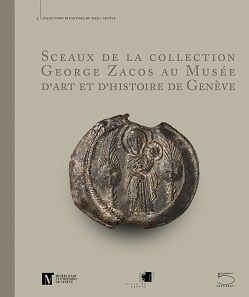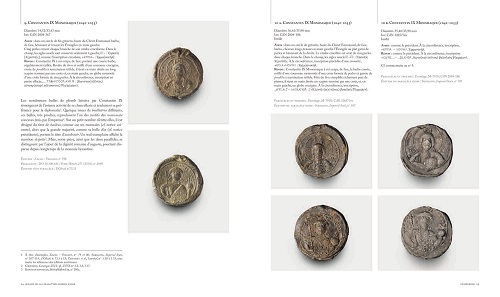by Ursula Kampmann
translated by Annika Backe
April 28, 2016 – We have nearly become used to new books being published by the Geneva Musée d’Art et d’Histoire on a regular basis: once again, it presents a bibliophile styled masterpiece which, lavishly illustrated, covers a fascinating area, here the Byzantine lead seals.
Maria Campagnolo-Pothitou and Jean-Claude Cheynet, Sceaux de la Collection George Zakos – Collections Byzantines du MAH – Genève. Milan 2016. 24 x 28.5 cm. Hardcover with jacket. 524 pages with 840 color illustrations. ISBN 978-88-7439-707-5. 100 euros.
Anyone who has ever dealt with this area could not get around one name. I am speaking of the couple George and Janet Zakos, both of which were zealous admirers of Byzantine art. In almost 40 years, George Zakos (1911-1983) assembled 18,000 or so Byzantine seals which were divided into two parts. The entire first part, comprising roughly 10,000 objects, was sold to a collector in 1951.
Portions of the second part, of which some of the material was published in two magnificent catalog volumes, went to the Bibliothèque nationale and onto the art market.
The Musée d’Art et d’Histoire, which possesses the Byzantine objects from the Zakos Collection, received yet another part of the seals: historically important and almost without exception in a wonderful state of preservation, the 480 specimens from the George Zakos Collection are presented in the new catalog, including a boulloterion, a pincerlike tool that helped pressing the malleable lead around a string and form it into a seal.
From Jean-Claude Cheynet, the renowned expert on Byzantine sigillography, comes a two-page introduction into the subject-matter.
A view inside the book.
Responsible for the seals was Maria Campagnolo-Pothitou. With great meticulousness and loving attention to detail, she has written an elaborate catalog that leaves nothing to be desired. Not only is every seal illustrated with superb photographs, but it is also described in minute detail and thoroughly commented on. The catalog is divided according to seal categories with the imperial objects addressed first, followed up by those of the central administration, the provincial administration, the officials at the court and church dignitaries, and finally the seals whose owners cannot be ascertained for sure anymore. Seals from the Crusader States and the Western world are also examined, as are tesserae from the Byzantine Empire.
Comprehensive indices on names, titles and functions, places and iconographic details complete the book that is concluded by a glossary and an extensive bibliography.
Everybody who knew Janet Zakos knows that she would have been delighted by this book that has been prepared with great expertise and love. It shows the Byzantine seals for what they are: works of art and, at the same time, historical testimonies of the first rank. Anyone engaging in this area should make sure to buy this work for his own library.
Here you may buy the book directly.
Und for all those who haven’t been to the Musée d’Art et d’Histoire for some time: you can purchase other books on Byzantine treasures there as well:
- the 315-page catalog of the objects from the Zakos Collection for CHF 65, and
- the 192-page volume on the Byzantine weights for CHF 60.
By the way, we have already introduced the latter in CoinsWeekly.






